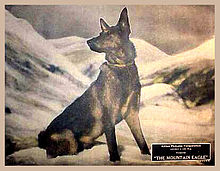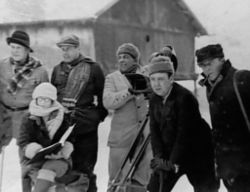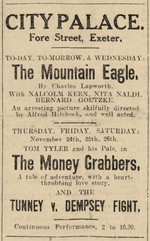The Mountain Eagle (lost silent Alfred Hitchcock film; 1927): Difference between revisions
ObscurusDoom (talk | contribs) (Created page with "{{InfoboxLost |title=<center>The Mountain Eagle (lost silent Alfred Hitchcock film; 1927)</center> |image=Lobbycard.jpg |imagecaption=A scan of the found lobby card |status=<s...") |
No edit summary |
||
| Line 1: | Line 1: | ||
{{InfoboxLost | {{InfoboxLost | ||
|title=<center>The Mountain Eagle | |title=<center>The Mountain Eagle</center> | ||
|image=Lobbycard.jpg | |image=Lobbycard.jpg | ||
|imagecaption=A scan of the found lobby card | |imagecaption=A scan of the found lobby card | ||
|status=<span style="color:red;">'''Lost'''</span> | |status=<span style="color:red;">'''Lost'''</span> | ||
}} | }} | ||
The Mountain Eagle is a 1927 British black and white and silent film that was directed by famous English film director and producer Alfred Hitchcock. This was Hitchcock's second film as a director following shortly after his first film "The Pleasure Garden" and his only film that is lost. | '''''The Mountain Eagle''''' is a 1927 British black and white and silent film that was directed by famous English film director and producer Alfred Hitchcock. This was Hitchcock's second film as a director following shortly after his first film "The Pleasure Garden" and his only film that is lost. | ||
==Film synopsis== | ==Film synopsis== | ||
| Line 48: | Line 48: | ||
As of today, The Mountain eagle has no surviving reels, making it the only unavailable film produced by Hitchcock and sits at the top of the BFI's ( British Film Institute's) list of most wanted lost films. However while there are no surviving reels, Publicity stills from the movies production stages are available. Along with that there are six surviving stills and frame enlargements found that are reproduced in a book of François Truffaut's. Plus what has been mentioned, more stills have been reproduced in Dan Auilers book. In 1998 during research done on the movie for an article, J.L Kuhns identified 43 different images from various collections and archives, some of which appear to be frame enlargements. A lobby card with a dog on it was found in a flea market in Rowley, Massachusetts in a box of broken frames and as of today is the only lobby card known to exist from the film. The latest find of anything related to the film took place in 2012, when 24 stills were found in the archive of who could only be disclosed as "someone close to Hitchcock" were auctioned off in Los Angeles with the winning bid being over $6000. | As of today, The Mountain eagle has no surviving reels, making it the only unavailable film produced by Hitchcock and sits at the top of the BFI's ( British Film Institute's) list of most wanted lost films. However while there are no surviving reels, Publicity stills from the movies production stages are available. Along with that there are six surviving stills and frame enlargements found that are reproduced in a book of François Truffaut's. Plus what has been mentioned, more stills have been reproduced in Dan Auilers book. In 1998 during research done on the movie for an article, J.L Kuhns identified 43 different images from various collections and archives, some of which appear to be frame enlargements. A lobby card with a dog on it was found in a flea market in Rowley, Massachusetts in a box of broken frames and as of today is the only lobby card known to exist from the film. The latest find of anything related to the film took place in 2012, when 24 stills were found in the archive of who could only be disclosed as "someone close to Hitchcock" were auctioned off in Los Angeles with the winning bid being over $6000. | ||
[[Category:Lost | [[Category:Lost films|Mountain Eagle, The (lost silent Alfred Hitchcock film; 1927)]] | ||
[[Category:Historic| | [[Category:Historic|Mountain Eagle, The (lost silent Alfred Hitchcock film; 1927)]] | ||
Revision as of 22:35, 12 April 2017
The Mountain Eagle is a 1927 British black and white and silent film that was directed by famous English film director and producer Alfred Hitchcock. This was Hitchcock's second film as a director following shortly after his first film "The Pleasure Garden" and his only film that is lost.
Film synopsis
There are several different accounts of what the film is about and they all vary slightly in one way or another. However to best sum up the film would be the film would be the summary by The Bioscope Newspaper on October 7th 1926, Which is exactly as follows:
|
"Beatrice Brent, school teacher in a small mountain village, incurs the enmity of Pettigrew, the local Justice of the Peace and owner of the village stores, because he believes that she encourages the attentions of his son Edward, a cripple, who takes evening lessons. Pettigrew, while questioning Beatrice, is himself influenced by her charm and attempts liberties which she strongly resents. He is so furious at the rebuff that he proclaims her as a wanton and she is driven from the village by the inhabitants. Beatrice is saved from their fury by a mysterious stranger known as Fearogod, who lives a solitary life in a cabin to which he takes her for shelter. To stop all scandal, Fearogod takes Beatrice down to the village and compels Pettigrew to marry them, explaining to her that he will help her to get a divorce. Beatrice, however, is content to leave the situation as it is, but Pettigrew, furious with rage, takes advantage of the fact that his son has left the village and arrests Fearogod for his murder. In spite of the fact that there is no vestige of evidence that young Pettigrew has been murdered, Fearogod is kept in prison for over a year, when he decides to escape. He finds that his wife has a baby and he goes off with them to the mountains. When they find that the baby is taken ill, Fearogod goes back to the village for a doctor, where he sees old Pettigrew. Some doubt as to which of the men is going to attack the other first is settled by an onlooker firing off a gun which wounds Pettigrew in the shoulder. The sudden return of his son Edward convinces the old man of the futility of proceeding with his accusation of murder, so he makes the best of matters by shaking hands with the man he has persecuted and all is supposed to end happily." |
The Actors
Not much is known about the complete cast other than it being said to have had a rather international cast of a wide variety. From what we know, this cast included but is not limited to these individuals. British actor Malcolm Keen playing the role of John "Fear o' God" Fulton. American actress Nita Naldi played the role of Beatrice Brent. Last, portraying J.P Pettigrew, we have German actor Bernhard Goetzke whom Hitchcock had befriended during the filming of a different movie, "Die Prinzessin und der geiger". (Literal translation: The princess and the violinist.) This movie was released to English audiences under a different name therefore is better known as "The Blackguard"
There was also believed to have been a dog in the film due to surviving Production stills and movie reviews. These along with a surviving Lobby card that was found in Massachusetts has confirmed there was indeed a dog in the film. According to the lobby card, the dog was called "Major". However it is unconfirmed if that's the dogs real name or the characters name. However, overall the dog's significance to the film and it's plot still remains a mystery to this day.
The Filming of the Movie
Despite Allegedly taking place in Kentucky, The Mountain Eagle was filmed in Munich Germany and southwestern Austria during October and November of 1925. Throughout filming of the movie there were several complications that seemingly plagued not only Hitchcock. It also seemingly cursed the crew and cast as well
During the filming of the movie Weather was an ongoing problem which seemingly brought more problems as it came. The day after they arrived in Obergurgel, Austria and started planning a filming schedule, they woke up to a little over a foot of snow on the ground. This meant they would have to wait at least 6 months before they could film everything there. They took their snow scenes before heading down the valley into a town called Umhaus. Umhaus only had a few inches of snow, so they worked with what they had. The next day the snow had gotten worse than it was in their original filming location.After four days of waiting,Hitchcock ended up going to the local fire brigade and after about half an hour of arguing, convinced them to get their engine and the manual pump and hose and go with Hitchcock.
They proceeded to into the town and blast and thaw the snow off of the roads, the houses, the roofs, the trees and the ground. However in the process the roof of a woman's house was partially destroyed due to the weight of the snow and the pressure of the hose. The mayor of the town demanded compensation of one shilling, However he gave her two. The filming of the movie proceeded to have several more mishaps. The villagers felt it was disrespectful when Hitchcock didn't stay in their inn, Hitchcock was constantly getting into arguments with Nita Naldi, Who at one point fainted on set due to hitting the ground too hard. Filming was eventually put on hold as Hitchcock ended up getting a case of altitude illness eventually during filming. This had caused him to start vomiting for unpredictable periods of time. He later blamed it as a reaction to the dialect of the locals. While he was a German speaker, he had issues comprehending their tongue.
The movie was finished near the start of December 1925.
First Release and Reception.
The film was first screened to specific individuals in Berlin in May 1926. It proceeded to be shown to the British press and producers in October of 1926, the producers not at all approving of it. It wasn't released at all until after the success of Hitchcock's February 1927 film "The Lodger: A Story of the London fog". (Which also starred Malcolm Keem.) The films great success and the public's demand for more of Hitchcock's films was what brought "The Mountain Eagle." to planned to be released for public viewing in May of 1927. It proceeded to have a seven month screening and distribution period in the U.K from June 1927 to January 1928 with what is believed to be two prints of the film. It has been theorized that Wardour films, distributors of film abandoned a widespread release due to favoring the idea of releasing Hitchcocks film "Downhill." resulting in few prints being made.
The film went on to be shown once in the Netherlands for a German film festival, twice in Spain for unknown reasons and was shown in the US 9 times from February 5th 1927 to December 9th 1929
Final Reception
The film went on to not be very much of a commercial success. It was stated to have "impressed neither the distributor nor the public" As with several of Hitchcock's early films, it was criticized quite harshly for its "lack of realism". In October of 1926 The ""Kinematograph"" described the film as being "Rather wandering and not too convincing of a story" and went on later to say the "continuation was jerky"
Later ""The Bioscope"" also later went on to criticized it for Having an air of unreality. Several years later, when French film director François Truffaut had an interview with Hitchcock and asked about the film, he described it with the following statement: "It was just a very bad movie". He later went on to describe it as "awful" and said he was not at all sorry about the movie having no surviving prints
Conservation status
As of today, The Mountain eagle has no surviving reels, making it the only unavailable film produced by Hitchcock and sits at the top of the BFI's ( British Film Institute's) list of most wanted lost films. However while there are no surviving reels, Publicity stills from the movies production stages are available. Along with that there are six surviving stills and frame enlargements found that are reproduced in a book of François Truffaut's. Plus what has been mentioned, more stills have been reproduced in Dan Auilers book. In 1998 during research done on the movie for an article, J.L Kuhns identified 43 different images from various collections and archives, some of which appear to be frame enlargements. A lobby card with a dog on it was found in a flea market in Rowley, Massachusetts in a box of broken frames and as of today is the only lobby card known to exist from the film. The latest find of anything related to the film took place in 2012, when 24 stills were found in the archive of who could only be disclosed as "someone close to Hitchcock" were auctioned off in Los Angeles with the winning bid being over $6000.


